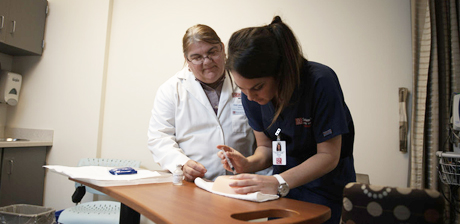October 20, 2014
Nursing Simulation Makes Lectures Come Alive
Simulation is the best stimulation for students learning health sciences, Rose Lange will tell you.
The associate professor with SVSU’s Crystal M. Lange College of Health & Human Services (no, the two Langes are not related) is making a legacy of her own by implementing programs and exercises that put students in her field as close to real world situations as possible.
The Saginaw native, who started at the university in 2001, has ramped up those efforts since the $28 million Health & Human Services Building opened in 2010.  The 90,000-square foot facility, in addition to housing classrooms and cutting edge equipment, also hosts mock hospital rooms, pseudo apartments and occupational therapy space.
The 90,000-square foot facility, in addition to housing classrooms and cutting edge equipment, also hosts mock hospital rooms, pseudo apartments and occupational therapy space.
Such resources provide Lange and her students a makeshift playground where they can simulate the work of professionals in the health sciences.
“It’s like making a lecture come alive,” said Lange, who was exposed to the same type of training while studying as an undergraduate at the University of Michigan.
One of the initiatives she has spearheaded is what she calls “the poverty simulator.” The once-a-semester exercise gives her pupils an idea of what it’s like to live as many health care consumers do—with very little.
“We’re able to provide some more depth to the information we provide in lectures,” said Lange, who is married to Gary Lange, professor of biology. “It connects our clinical to our didactic (studies).”
The poverty simulation takes place in a large room on the first floor of the Health & Human Services Building, where students’ chairs represent their simulated homes. The room substitutes as a neighborhood, complete with surrounding chairs representing resources such as schools, grocery stores, pawn shops and police stations.
Some students are grouped together as families. They are assigned resources and situations typical of people in poverty, and then asked to navigate the pretend neighborhood in an effort to complete tasks. A month’s worth of living is compacted into one day’s class.
“They have to experience long lines, lack of transportation, the inability to have enough money to buy things,” Lange said of the students’ experience. “Sometimes they get evicted from their house. There are a lot of issues that come up.” She said the simulation gives students “a better expectation of what their patients might experience,” Lange said. “We’ve had a lot of positive responses from students. It makes a difference.”
